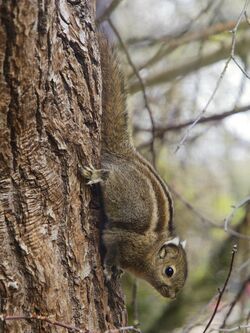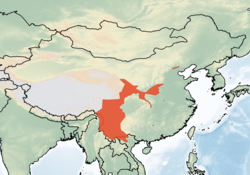Biology:Swinhoe's striped squirrel
| Swinhoe's striped squirrel | |
|---|---|

| |
| Scientific classification | |
| Domain: | Eukaryota |
| Kingdom: | Animalia |
| Phylum: | Chordata |
| Class: | Mammalia |
| Order: | Rodentia |
| Family: | Sciuridae |
| Genus: | Tamiops |
| Species: | T. swinhoei
|
| Binomial name | |
| Tamiops swinhoei (A. Milne-Edwards, 1874)
| |
| Subspecies[2] | |
| |

| |
Swinhoe's striped squirrel (Tamiops swinhoei) is a small species of rodent in the family Sciuridae.[3] This species is found mostly in China and Southeast Asia. Their diet consists of mostly seeds, fruits, nuts and ginger nectar. Like most squirrels they live in forest areas with mountains, usually in groups. They have litters that average in size of 3.25 offspring.[4]
Physical features
They are small bodied with stripes running from their nose to their neck and a second set that run the length of their body to their tail. The stripes range in color from yellow to brown cinnamon. Small tufts of white fur can be seen on the tips of their ears. They have dense fur to accommodate for the high elevation where they live. Females have a longer tail than males.[4]
Reproduction
Swinhoe's striped squirrels usually breed once every six months. On average they can have 3-6 offspring in a litter.[4]
Diet
Swinhoe's striped squirrel are herbivores. They eat mostly nuts, seeds, fruits, and ginger nectar. They collect their food and store it for later dates when food is scarce.[5]
Ecosystem contributions
Consuming seeds and nuts is helpful to disperse seeds and nuts in order for more to grow. This species of squirrel also helps humans survive by being a source of food.[4]
Distribution and habitat
Swinhoe's striped squirrel is found mostly in Southeast Asia, China, Vietnam, Myanmar, Hainan Island, and possibly Laos.[4] They live in tropical rain forest, where there are many mountains, in mostly couples and groups.[5]
References
- ↑ Duckworth, J.W. (2017). "Tamiops swinhoei". IUCN Red List of Threatened Species 2017: e.T21382A22252396. doi:10.2305/IUCN.UK.2017-2.RLTS.T21382A22252396.en. https://www.iucnredlist.org/species/21382/22252396. Retrieved 12 November 2021.
- ↑ Thorington, R.W. Jr.; Hoffmann, R.S. (2005). "Family Sciuridae". in Wilson, D.E.; Reeder, D.M. Mammal Species of the World: a taxonomic and geographic reference (3rd ed.). The Johns Hopkins University Press. pp. 754–818. ISBN 0-8018-8221-4. OCLC 26158608. https://www.departments.bucknell.edu/biology/resources/msw3/browse.asp?id=12400001.
- ↑ "Tamiops swinhoei - Swinhoe's Striped Squirrel | eMammal". https://emammal.si.edu/content/tamiops-swinhoei-swinhoes-striped-squirrel.
- ↑ 4.0 4.1 4.2 4.3 4.4 Minton, Janet. "Tamiops swinhoei (Swinhoe's striped squirrel)" (in en). https://animaldiversity.org/accounts/Tamiops_swinhoei/.
- ↑ 5.0 5.1 "Animalsort - Swinhoe's striped squirrel". http://www.animalsort.com/species/42-swinhoes-striped-squirrel.
Wikidata ☰ Q3729909 entry
 |


